Berg J.M., Tymoczko J.L., Stryer L. Biochemistry
Подождите немного. Документ загружается.


3. Adipose tissue. The triacylglycerols stored in adipose tissue are an enormous reservoir of metabolic fuel (see Table
30.1). In a typical 70-kg man, the 15 kg of triacylglycerols have an energy content of 135,000 kcal (565,000 kJ). Adipose
tissue is specialized for the esterification of fatty acids and for their release from triacylglycerols. In human beings, the
liver is the major site of fatty acid synthesis. Recall that these fatty acids are esterified in the liver to glycerol phosphate
to form triacylglycerol and are transported to the adipose tissue in lipoprotein particles, such as very low density
lipoproteins (Section 26.3.1). Triacylglycerols are not taken up by adipocytes; rather, they are first hydrolyzed by an
extracellular lipoprotein lipase for uptake. This lipase is stimulated by processes initiated by insulin. After the fatty acids
enter the cell, the principal task of adipose tissue is to activate these fatty acids and transfer the resulting CoA derivatives
to glycerol in the form of glycerol 3-phosphate. This essential intermediate in lipid biosynthesis comes from the
reduction of the glycolytic intermediate dihydroxyacetone phosphate. Thus, adipose cells need glucose for the synthesis
of triacylglycerols (Figure 30.13).
Triacylglycerols are hydrolyzed to fatty acids and glycerol by intracellular lipases. The release of the first fatty acid from
a triacylglycerol, the rate-limiting step, is catalyzed by a hormone-sensitive lipase that is reversibly phosphorylated. The
hormone epinephrine stimulates the formation of cyclic AMP, the intracellular messenger in the amplifying cascade,
which activates a protein kinase
a recurring theme in hormone action. Triacylglycerols in adipose cells are continually
being hydrolyzed and resynthesized. Glycerol derived from their hydrolysis is exported to the liver. Most of the fatty
acids formed on hydrolysis are reesterified if glycerol 3-phosphate is abundant. In contrast, they are released into the
plasma if glycerol 3-phosphate is scarce because of a paucity of glucose. Thus, the glucose level inside adipose cells is a
major factor in determining whether fatty acids are released into the blood.
4. The kidney. The major purpose of the kidney is to produce urine, which serves as a vehicle for excreting metabolic
waste products and for maintaining the osmolarity of the body fluids. The blood plasma is filtered nearly 60 times each
day in the renal tubules. Most of the material filtered out of the blood is reabsorbed; so only 1 to 2 liters of urine is
produced. Water-soluble materials in the plasma, such as glucose, and water itself are reabsorbed to prevent wasteful
loss. The kidneys require large amounts of energy to accomplish the reabsorption. Although constituting only 0.5% of
body mass, kidneys consume 10% of the oxygen used in cellular respiration. Much of the glucose that is reabsorbed is
carried into the kidney cells by the sodium-glucose cotransporter. Recall that this transporter is powered by the Na
+
-K
+
gradient, which is itself maintained by the Na
+
-K
+
ATPase (Section 13.4). During starvation, the kidney becomes an
important site of gluconeogenesis and may contribute as much as half of the blood glucose.
5. Liver. The metabolic activities of the liver are essential for providing fuel to the brain, muscle, and other peripheral
organs. Indeed, the liver, which can be from 2% to 4% of body weight, is an organism's metabolic hub (Figure 30.14).
Most compounds absorbed by the intestine first pass through the liver, which is thus able to regulate the level of many
metabolites in the blood.
Let us first consider how the liver metabolizes carbohydrates. The liver removes two-thirds of the glucose from the blood
and all of the remaining monosaccharides. Some glucose is left in the blood for use by other tissues. The absorbed
glucose is converted into glucose 6-phosphate by hexokinase and the liver-specific glucokinase. Glucose 6-phosphate, as
already stated, has a variety of fates, although the liver uses little of it to meet its own energy needs. Much of the glucose
6-phosphate is converted into glycogen. As much as 400 kcal (1700 kJ) can be stored in this form in the liver. Excess
glucose 6-phosphate is metabolized to acetyl CoA, which is used to form fatty acids, cholesterol, and bile salts. The
pentose phosphate pathway, another means of processing glucose 6-phosphate, supplies the NADPH for these reductive
biosyntheses. The liver can produce glucose for release into the blood by breaking down its store of glycogen and by
carrying out gluconeogenesis. The main precursors for gluconeogenesis are lactate and alanine from muscle, glycerol
from adipose tissue, and glucogenic amino acids from the diet.
The liver also plays a central role in the regulation of lipid metabolism. When fuels are abundant, fatty acids derived
from the diet or synthesized by the liver are esterified and secreted into the blood in the form of very low density
lipoprotein (see Figure 30.15). However, in the fasting state, the liver converts fatty acids into ketone bodies. How is the
fate of liver fatty acids determined? The selection is made according to whether the fatty acids enter the mitochondrial
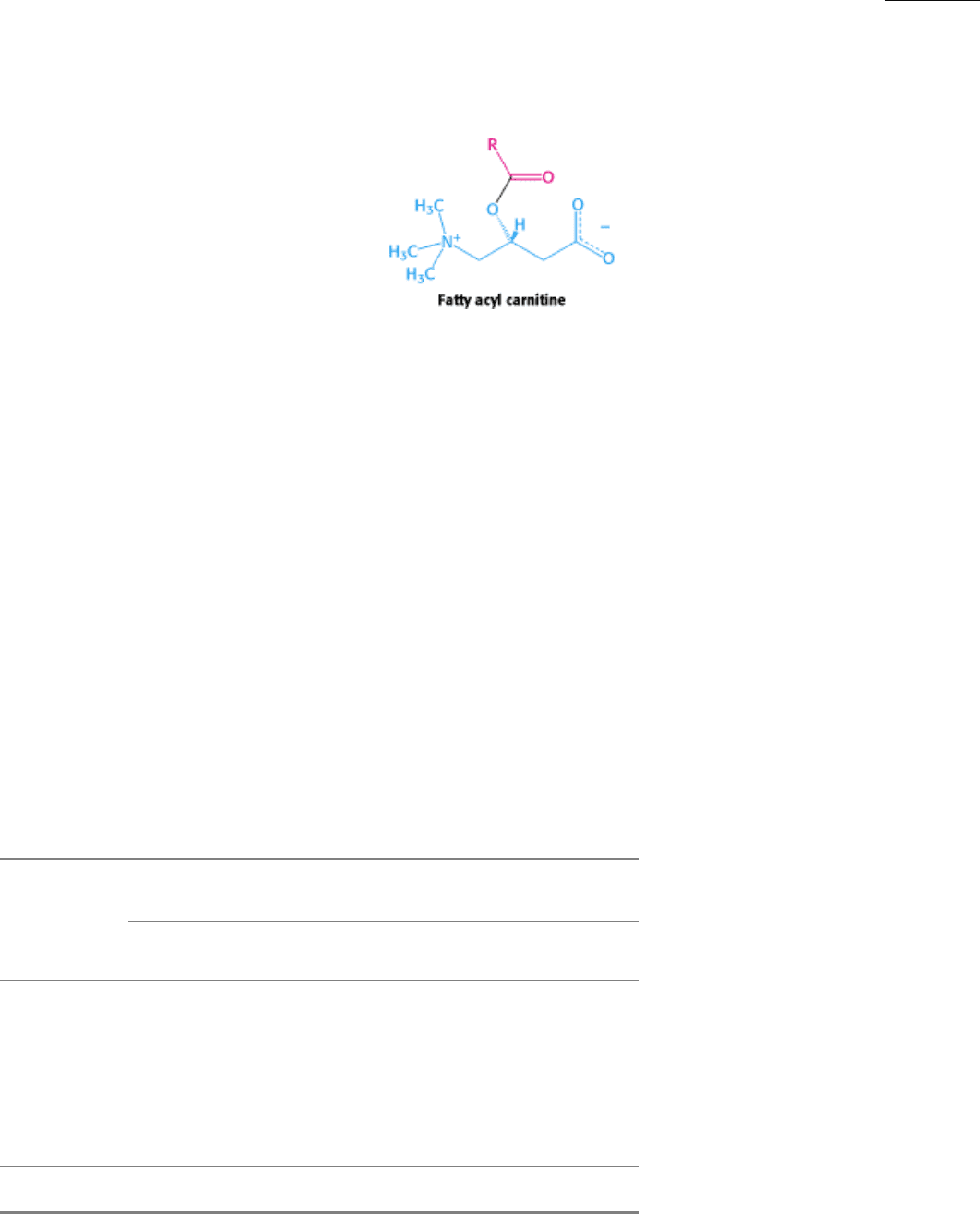
matrix. Recall that long-chain fatty acids traverse the inner mitochondrial membrane only if they are esterified to
carnitine. Carnitine acyltransferase I (also known as carnitine palmitoyl transferase I), which catalyzes the formation of
acyl carnitine, is inhibited by malonyl CoA, the committed intermediate in the synthesis of fatty acids (see Figure 30.9).
Thus, when malonyl CoA is abundant, long-chain fatty acids are prevented from entering the mitochondrial matrix, the
compartment of β-oxidation and ketone-body formation. Instead, fatty acids are exported to adipose tissue for
incorporation into triacylglycerols. In contrast, the level of malonyl CoA is low when fuels are scarce. Under these
conditions, fatty acids liberated from adipose tissues enter the mitochondrial matrix for conversion into ketone bodies.
The liver also plays an essential role in dietary amino acid metabolism. The liver absorbs the majority of amino acids,
leaving some in the blood for peripheral tissues. The priority use of amino acids is for protein synthesis rather than
catabolism. By what means are amino acids directed to protein synthesis in preference to use as a fuel? The K
M
value
for the aminoacyl-tRNA synthetases is lower than that of the enzymes taking part in amino acid catabolism. Thus, amino
acids are used to synthesize aminoacyl-tRNAs before they are catabolized. When catabolism does take place, the first
step is the removal of nitrogen, which is subsequently processed to urea. The liver secretes from 20 to 30 g of urea a day.
The α-ketoacids are then used for gluconeogenesis or fatty acid synthesis. Interestingly, the liver cannot remove nitrogen
from the branch-chain amino acids (leucine, isoleucine, and valine). Transamination takes place in the muscle.
How does the liver meet its own energy needs? α-Ketoacids derived from the degradation of amino acids are the liver's
own fuel. In fact, the main role of glycolysis in the liver is to form building blocks for biosyntheses. Furthermore, the
liver cannot use acetoacetate as a fuel, because it has little of the transferase needed for acetoacetate's activation to acetyl
CoA. Thus, the liver eschews the fuels that it exports to muscle and the brain.
III. Synthesizing the Molecules of Life 30. The Integration of Metabolism 30.2. Each Organ Has a Unique Metabolic Profile
Table 30.1. Fuel reserves in a typical 70-kg man
Available energy in kcal (kJ)
Organ Glucose or glycogen Triacylglycerols Mobilizable proteins
Blood 60 (250) 45 (200) 0 (0)
Liver 400 (1700) 450 (2000) 400 (1700)
Brain 8 (30) 0 (0) 0 (0)
Muscle 1,200 (5000) 450 (2000) 24,000 (100,000)
Adipose tissue 80 (330) 135,000 (560,000) 40 (170)
Source: After G. F. Cahill, Jr. Clin. Endocrinol. Metab. 5(1976):398.
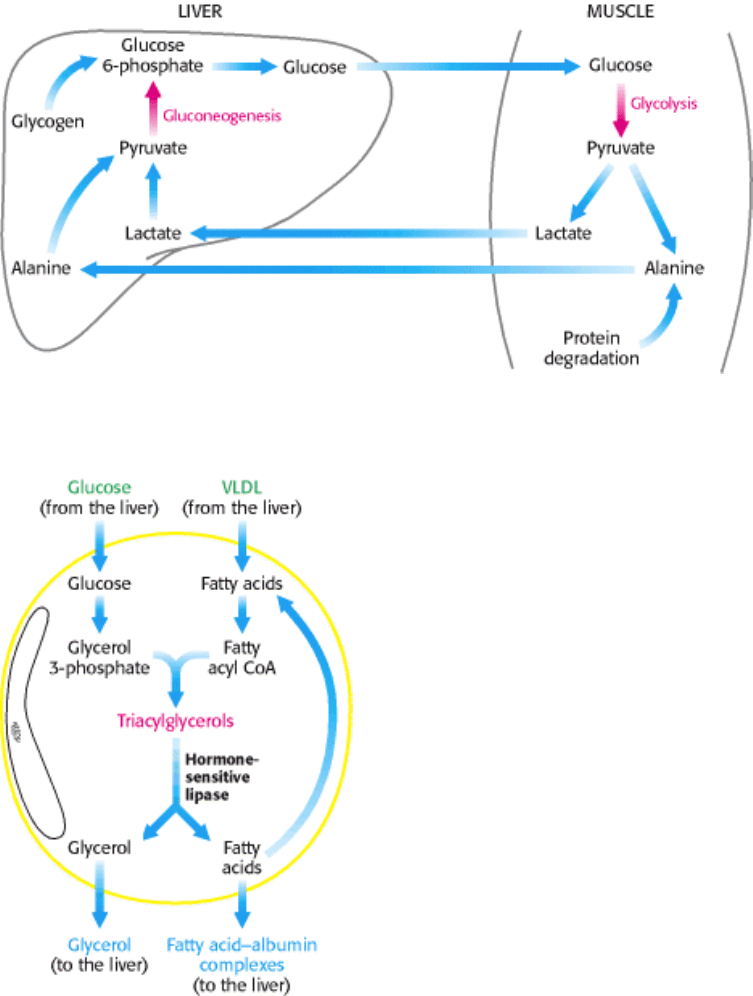
III. Synthesizing the Molecules of Life 30. The Integration of Metabolism 30.2. Each Organ Has a Unique Metabolic Profile
Figure 30.12. Metabolic Interchanges between Muscle and Liver.
III. Synthesizing the Molecules of Life 30. The Integration of Metabolism 30.2. Each Organ Has a Unique Metabolic Profile
Figure 30.13. Synthesis and Degradation of Triacylglycerols by Adipose Tissue. Fatty acids are delivered to adipose
cells in the form of triacylglycerols contained in very low density lipoproteins (VLDLs).
III. Synthesizing the Molecules of Life 30. The Integration of Metabolism 30.2. Each Organ Has a Unique Metabolic Profile
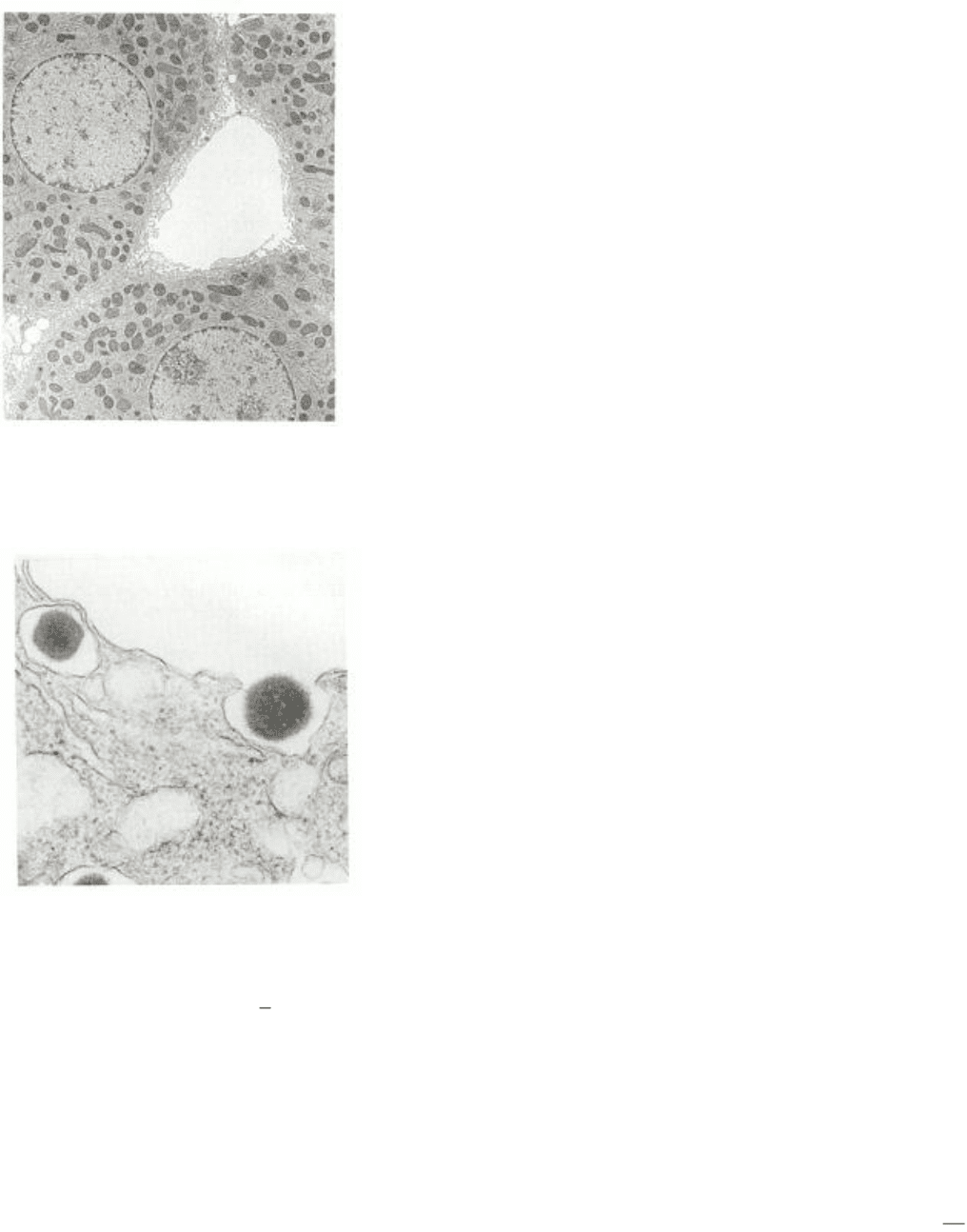
Figure 30.14. Electron Micrograph of Liver Cells. The liver plays an essential role in the integration of metabolism.
[Courtesy of Dr. Ann Hubbard.]
III. Synthesizing the Molecules of Life 30. The Integration of Metabolism 30.2. Each Organ Has a Unique Metabolic Profile
Figure 30.15. Insulin Secretion. The electron micrograph shows the release of insulin from a pancreatic β cell. One
secretory granule is on the verge of fusing with the plasma membrane and releasing insulin into the extracellular space,
and the other has already released the hormone. [Courtesy of Dr. Lelio Orci. L. Orci, J.-D. Vassalli, and A. Perrelet. Sci.
Am. 259 (September 1988):85 94.]
III. Synthesizing the Molecules of Life 30. The Integration of Metabolism
30.3. Food Intake and Starvation Induce Metabolic Changes
We shall now consider the biochemical responses to a series of physiological conditions. Our first example is the starved-
fed cycle, which we all experience in the hours after an evening meal and through the night's fast. This nightly starved-
fed cycle has three stages: the postabsorptive state after a meal, the early fasting during the night, and the refed state after
breakfast. A major goal of the many biochemical alterations in this period is to maintain glucose homeostasis
that is, a
constant blood-glucose level.
1. The well-fed, or postabsorptive, state. After we consume and digest an evening meal, glucose and amino acids are
transported from the intestine to the blood. The dietary lipids are packaged into chylomicrons and transported to the
blood by the lymphatic system. This fed condition leads to the secretion of insulin, which is one of the two most

important regulators of fuel metabolism, the other regulator being glucagon. The secretion of the hormone insulin by the
β cells of the pancreas is stimulated by glucose and the parasympathetic nervous system (Figure 30.15). In essence,
insulin signals the fed state it stimulates the storage of fuels and the synthesis of proteins in a variety of ways. For
instance, insulin initiates protein kinase cascades it stimulates glycogen synthesis in both muscle and the liver and
suppresses gluconeogenesis by the liver. Insulin also accelerates glycolysis in the liver, which in turn increases the
synthesis of fatty acids.
The liver helps to limit the amount of glucose in the blood during times of plenty by storing it as glycogen so as to be
able to release glucose in times of scarcity. How is the excess blood glucose present after a meal removed? Insulin
accelerates the uptake of blood glucose into the liver by GLUT2. The level of glucose 6-phosphate in the liver rises
because only then do the catalytic sites of glucokinase become filled with glucose. Recall that glucokinase is active only
when blood-glucose levels are high. Consequently, the liver forms glucose 6-phosphate more rapidly as the blood-
glucose level rises. The increase in glucose 6-phosphate coupled with insulin action leads to a buildup of glycogen
stores. The hormonal effects on glycogen synthesis and storage are reinforced by a direct action of glucose itself.
Phosphorylase a is a glucose sensor in addition to being the enzyme that cleaves glycogen. When the glucose level is
high, the binding of glucose to phosphorylase a renders the enzyme susceptible to the action of a phosphatase that
converts it into phosphorylase b, which does not readily degrade glycogen. Thus, glucose allosterically shifts the
glycogen system from a degradative to a synthetic mode.
The high insulin level in the fed state also promotes the entry of glucose into muscle and adipose tissue. Insulin
stimulates the synthesis of glycogen by muscle as well as by the liver. The entry of glucose into adipose tissue provides
glycerol 3-phosphate for the synthesis of triacylglycerols. The action of insulin also extends to amino acid and protein
metabolism. Insulin promotes the uptake of branched-chain amino acids (valine, leucine, and isoleucine) by muscle.
Indeed, insulin has a general stimulating effect on protein synthesis, which favors a building up of muscle protein. In
addition, it inhibits the intracellular degradation of proteins.
2. The early fasting state. The blood-glucose level begins to drop several hours after a meal, leading to a decrease in
insulin secretion and a rise in glucagon secretion; glucagon is secreted by the α cells of the pancreas in response to a low
blood-sugar level in the fasting state. Just as insulin signals the fed state, glucagon signals the starved state. It serves to
mobilize glycogen stores when there is no dietary intake of glucose. The main target organ of glucagon is the liver.
Glucagon stimulates glycogen breakdown and inhibits glycogen synthesis by triggering the cyclic AMP cascade leading
to the phosphorylation and activation of phosphorylase and the inhibition of glycogen synthase (Section 21.5). Glucagon
also inhibits fatty acid synthesis by diminishing the production of pyruvate and by lowering the activity of acetyl CoA
carboxylase by maintaining it in an unphosphorylated state. In addition, glucagon stimulates gluconeogenesis in the liver
and blocks glycolysis by lowering the level of F-2,6-BP.
All known actions of glucagon are mediated by protein kinases that are activated by cyclic AMP. The activation of the
cyclic AMP cascade results in a higher level of phosphorylase a activity and a lower level of glycogen synthase a
activity. Glucagon's effect on this cascade is reinforced by the diminished binding of glucose to phosphorylase a, which
makes the enzyme less susceptible to the hydrolytic action of the phosphatase. Instead, the phosphatase remains bound to
phosphorylase a, and so the synthase stays in the in-active phosphorylated form. Consequently, there is a rapid
mobilization of glycogen.
The large amount of glucose formed by the hydrolysis of glucose 6-phosphate derived from glycogen is then released
from the liver into the blood. The entry of glucose into muscle and adipose tissue decreases in response to a low insulin
level. The diminished utilization of glucose by muscle and adipose tissue also contributes to the maintenance of the
bloodglucose level. The net result of these actions of glucagon is to markedly increase the release of glucose by the liver.
Both muscle and liver use fatty acids as fuel when the blood-glucose level drops. Thus, the blood-glucose level is kept at
or above 80 mg/dl by three major factors: (1) the mobilization of glycogen and the release of glucose by the liver, (2) the
release of fatty acids by adipose tissue, and (3) the shift in the fuel used from glucose to fatty acids by muscle and the

liver.
What is the result of depletion of the liver's glycogen stores? Gluconeogenesis from lactate and alanine continues, but
this process merely replaces glucose that had already been converted into lactate and alanine by the peripheral tissues.
Moreover, the brain oxidizes glucose completely to CO
2
and H
2
O. Thus, for the net synthesis of glucose to occur,
another source of carbons is required. Glycerol released from adipose tissue on lipolysis provides some of the carbons,
with the remaining carbons coming from the hydrolysis of muscle proteins.
3. The refed state. What are the biochemical responses to a hearty breakfast? Fat is processed exactly as it is processed in
the normal fed state. However, this is not the case for glucose. The liver does not initially absorb glucose from the blood,
but rather leaves it for the peripheral tissues. Moreover, the liver remains in a gluconeogenic mode. Now, however, the
newly synthesized glucose is used to replenish the liver's glycogen stores. As the blood-glucose levels continue to rise,
the liver completes the replenishment of its glycogen stores and begins to process the remaining excess glucose for fatty
acid synthesis.
30.3.1. Metabolic Adaptations in Prolonged Starvation Minimize Protein Degradation
What are the adaptations if fasting is prolonged to the point of starvation? A typical well-nourished 70-kg man has
fuel reserves totaling about 161,000 kcal (670,000 kJ; see Table 30.1). The energy need for a 24-hour period
ranges from about 1600 kcal (6700 kJ) to 6000 kcal (25,000 kJ), depending on the extent of activity. Thus, stored fuels
suffice to meet caloric needs in starvation for 1 to 3 months. However, the carbohydrate reserves are exhausted in only a
day.
Even under starvation conditions, the blood-glucose level must be maintained above 2.2 mM (40 mg/dl). The first
priority of metabolism in starvation is to provide sufficient glucose to the brain and other tissues (such as red blood
cells) that are absolutely dependent on this fuel. However, precursors of glucose are not abundant. Most energy is stored
in the fatty acyl moieties of triacylglycerols. Recall that fatty acids cannot be converted into glucose, because acetyl CoA
cannot be transformed into pyruvate (Section 22.3.7). The glycerol moiety of triacylglycerol can be converted into
glucose, but only a limited amount is available. The only other potential source of glucose is amino acids derived from
the breakdown of proteins. However, proteins are not stored, and so any breakdown will necessitate a loss of function.
Thus, the second priority of metabolism in starvation is to preserve protein, which is accomplished by shifting the fuel
being used from glucose to fatty acids and ketone bodies (Figure 30.16).
The metabolic changes on the first day of starvation are like those after an overnight fast. The low blood-sugar level
leads to decreased secretion of insulin and increased secretion of glucagon. The dominant metabolic processes are the
mobilization of triacylglycerols in adipose tissue and gluconeogenesis by the liver. The liver obtains energy for its own
needs by oxidizing fatty acids released from adipose tissue. The concentrations of acetyl CoA and citrate consequently
increase, which switches off glycolysis. The uptake of glucose by muscle is markedly diminished because of the low
insulin level, whereas fatty acids enter freely. Consequently, muscle shifts almost entirely from glucose to fatty acids for
fuel. The β-oxidation of fatty acids by muscle halts the conversion of pyruvate into acetyl CoA, because acetyl CoA
stimulates the phosphorylation of the pyruvate dehydrogenase complex, which renders it inactive (Section 17.2.1).
Hence, pyruvate, lactate, and alanine are exported to the liver for conversion into glucose. Glycerol derived from the
cleavage of triacylglycerols is another raw material for the synthesis of glucose by the liver.
Proteolysis also provides carbon skeletons for gluconeogenesis. During starvation, degraded proteins are not replenished
and serve as carbon sources for glucose synthesis. Initial sources of protein are those that turn over rapidly, such as
proteins of the intestinal epithelium and the secretions of the pancreas. Proteolysis of muscle protein provides some of
three-carbon precursors of glucose. However, survival for most animals depends on being able to move rapidly, which
requires a large muscle mass, and so muscle loss must be minimized.
How is the loss of muscle curtailed? After about 3 days of starvation, the liver forms large amounts of acetoacetate and
d-

3-hydroxybutyrate (ketone bodies; Figure 30.17). Their synthesis from acetyl CoA increases markedly because the citric
acid cycle is unable to oxidize all the acetyl units generated by the degradation of fatty acids. Gluconeogenesis depletes
the supply of oxaloacetate, which is essential for the entry of acetyl CoA into the citric acid cycle. Consequently, the
liver produces large quantities of ketone bodies, which are released into the blood. At this time, the brain begins to
consume appreciable amounts of acetoacetate in place of glucose. After 3 days of starvation, about a third of the energy
needs of the brain are met by ketone bodies (Table 30.2). The heart also uses ketone bodies as fuel.
After several weeks of starvation, ketone bodies become the major fuel of the brain. Acetoacetate is activated by the
transfer of CoA from succinyl CoA to give acetoacetyl CoA (Figure 30.18). Cleavage by thiolase then yields two
molecules of acetyl CoA, which enter the citric acid cycle. In essence, ketone bodies are equivalents of fatty acids that
can pass through the blood-brain barrier. Only 40 g of glucose is then needed per day for the brain, compared with
about 120 g in the first day of starvation. The effective conversion of fatty acids into ketone bodies by the liver and their
use by the brain markedly diminishes the need for glucose. Hence, less muscle is degraded than in the first days of
starvation. The breakdown of 20 g of muscle daily compared with 75 g early in starvation is most important for survival.
A person's survival time is mainly determined by the size of the triacylglycerol depot.
What happens after depletion of the triacylglycerol stores? The only source of fuel that remains is proteins. Protein
degradation accelerates, and death inevitably results from a loss of heart, liver, or kidney function.
30.3.2. Metabolic Derangements in Diabetes Result from Relative Insulin Insufficiency
and Glucagon Excess
We now consider diabetes mellitus, a complex disease characterized by grossly abnormal fuel usage: glucose is
overproduced by the liver and underutilized by other organs. The incidence of diabetes mellitus (usually referred
to simply as diabetes) is about 5% of the population. Indeed, diabetes is the most common serious metabolic disease in
the world; it affects hundreds of millions. Type I diabetes, or insulin-dependent diabetes mellitus (IDDM), is caused by
autoimmune destruction of the insulinsecreting β cells in the pancreas and usually begins before age 20. The term insulin-
dependent means that the individual requires insulin to live. Most diabetics, in contrast, have a normal or even higher
level of insulin in their blood, but they are quite unresponsive to the hormone. This form of the disease
known as type
II, or non-insulin-dependent, diabetes mellitus (NIDDM) typically arises later in life than does the insulin-dependent
form.
Diabetes-
Named for the excessive urination in the disease. Aretaeus, a
Cappadocian physician of the second century
a.d., wrote: "The
epithet diabetes has been assigned to the disorder, being something
like passing of water by a siphon." He perceptively characterized
diabetes as "being a melting-down of the flesh and limbs into urine."
From Latin, meaning "sweetened with honey." Refers to the
presence of sugar in the urine of patients having the disease.
Mellitus distinguishes this disease from diabetes insipidus, which is
caused by impaired renal reabsorption of water.
In type I diabetes, insulin is absent and consequently glucagon is present at higher-than-normal levels. In essence, the
diabetic person is in biochemical starvation mode despite a high concentration of blood glucose. Because insulin is
deficient, the entry of glucose into cells is impaired. The liver becomes stuck in a gluconeogenic and ketogenic state. The
excessive level of glucagon relative to insulin leads to a decrease in the amount of F-2,6-BP in the liver. Hence,
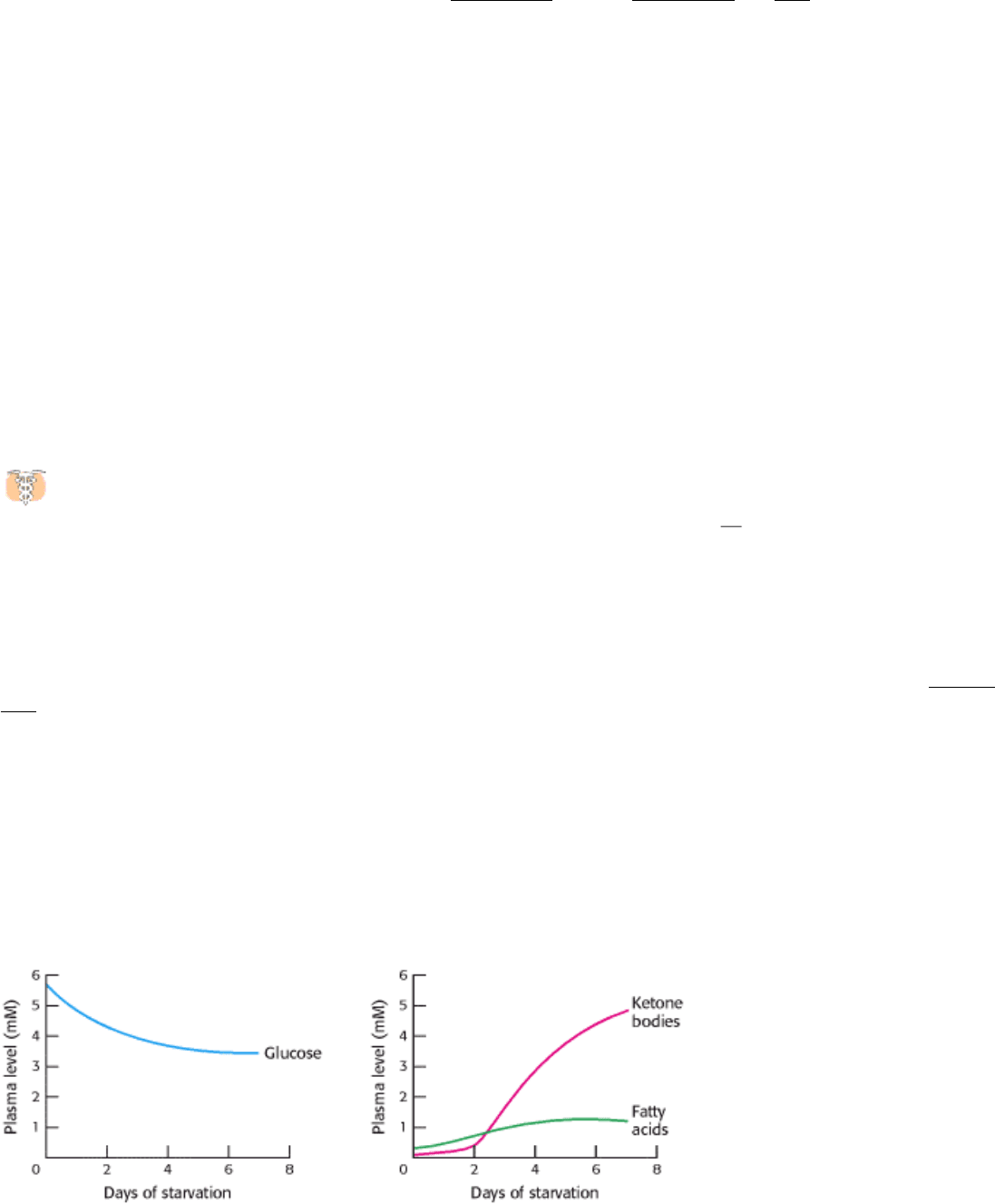
glycolysis is inhibited and gluconeogenesis is stimulated because of the opposite effects of F-2,6-BP on
phosphofructokinase and fructose-1,6-bisphosphatase (Section 16.4; see also Figures 30.4 and 30.6). The high glucagon/
insulin ratio in diabetes also promotes glycogen breakdown. Hence, an excessive amount of glucose is produced by the
liver and released into the blood. Glucose is excreted in the urine (hence the name mellitus) when its concentration in the
blood exceeds the reabsorptive capacity of the renal tubules. Water accompanies the excreted glucose, and so an
untreated diabetic in the acute phase of the disease is hungry and thirsty.
Because carbohydrate utilization is impaired, a lack of insulin leads to the uncontrolled breakdown of lipids and proteins.
Large amounts of acetyl CoA are then produced by β-oxidation. However, much of the acetyl CoA cannot enter the citric
acid cycle, because there is insufficient oxaloacetate for the condensation step. Recall that mammals can synthesize
oxaloacetate from pyruvate, a product of glycolysis, but not from acetyl CoA; instead, they generate ketone bodies. A
striking feature of diabetes is the shift in fuel usage from carbohydrates to fats; glucose, more abundant than ever, is
spurned. In high concentrations, ketone bodies overwhelm the kidney's capacity to maintain acid-base balance. The
untreated diabetic can go into a coma because of a lowered blood pH level and dehydration.
Type II, or non-insulin-dependent, diabetes accounts for more than 90% of the cases and usually develops in middle-
aged, obese people. The exact cause of type II diabetes remains to be elucidated, although a genetic basis seems likely.
30.3.3. Caloric Homeostasis: A Means of Regulating Body Weight
In the United States, obesity has become an epidemic, with nearly 20% of adults classified as obese. Obesity is
identified as a risk factor in a host of pathological conditions including diabetes mellitus, hypertension, and
cardiovascular disease. The cause of obesity is quite simple in the vast majority of cases more food is consumed than
is needed, and the excess calories are stored as fat.
Although the proximal cause of obesity is simple, the biochemical means by which caloric homeostasis and apetite
control are usually maintained is enormously complex, but two important signal molecules are insulin and leptin. A
protein consisting of 146 amino acids, leptin is a hormone secreted by adipocytes in direct proportion to fat mass. Leptin
acts through a membrane receptor (related in structure and mechanism of action to the growth-hormone receptor; Section
15.4) in the hypothalamus to generate satiation signals. During periods when more energy is expended than ingested (the
starved state), adipose tissue loses mass. Under these conditions, the secretion of both leptin and insulin declines, fuel
utilization is increased, and energy stores are used. The converse is true when calories are consumed in excess.
The importance of leptin to obesity is dramatically illustrated in mice. Mice lacking leptin are obese and will lose weight
if given leptin. Mice that lack the leptin receptor are insensitive to leptin administration. Preliminary evidence indicates
that leptin and its receptor play a role in human obesity, but the results are not as clear-cut as in the mouse. The interplay
of genes and their products to control caloric homeostasis will be an exciting area of research for some time to come.
III. Synthesizing the Molecules of Life 30. The Integration of Metabolism 30.3. Food Intake and Starvation Induce Metabolic Changes
Figure 30.16. Fuel Choice During Starvation. The plasma levels of fatty acids and ketone bodies increase in
starvation, whereas that of glucose decreases.
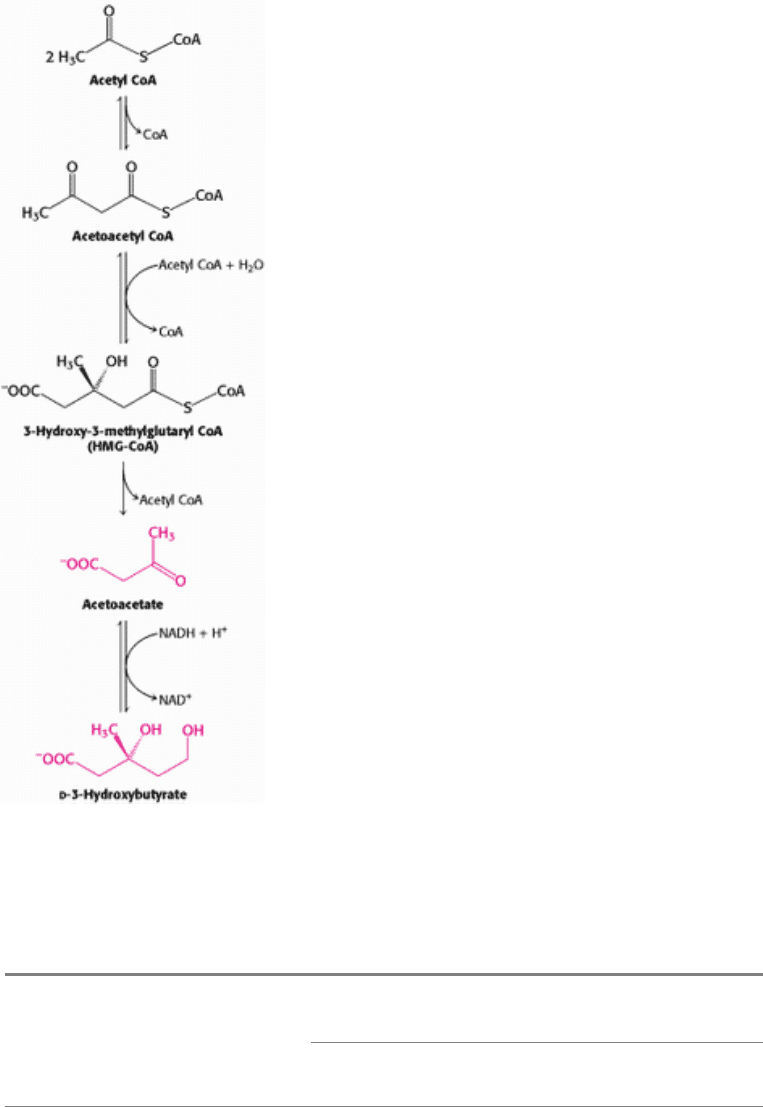
III. Synthesizing the Molecules of Life 30. The Integration of Metabolism 30.3. Food Intake and Starvation Induce Metabolic Changes
Figure 30.17. Synthesis of Ketone Bodies by the Liver.
III. Synthesizing the Molecules of Life 30. The Integration of Metabolism 30.3. Food Intake and Starvation Induce Metabolic Changes
Table 30.2. Fuel metabolism in starvation
Amount formed or consumed in 24 hours (grams)
Fuel exchanges and consumption 3d day 40th day
Fuel use by the brain
Glucose 100 40
Ketone bodies 50 100
All other use of glucose 50 40
Fuel mobilization
Adipose-tissue lipolysis 180 180
Muscle-protein degradation 75 20
Fuel output of the liver
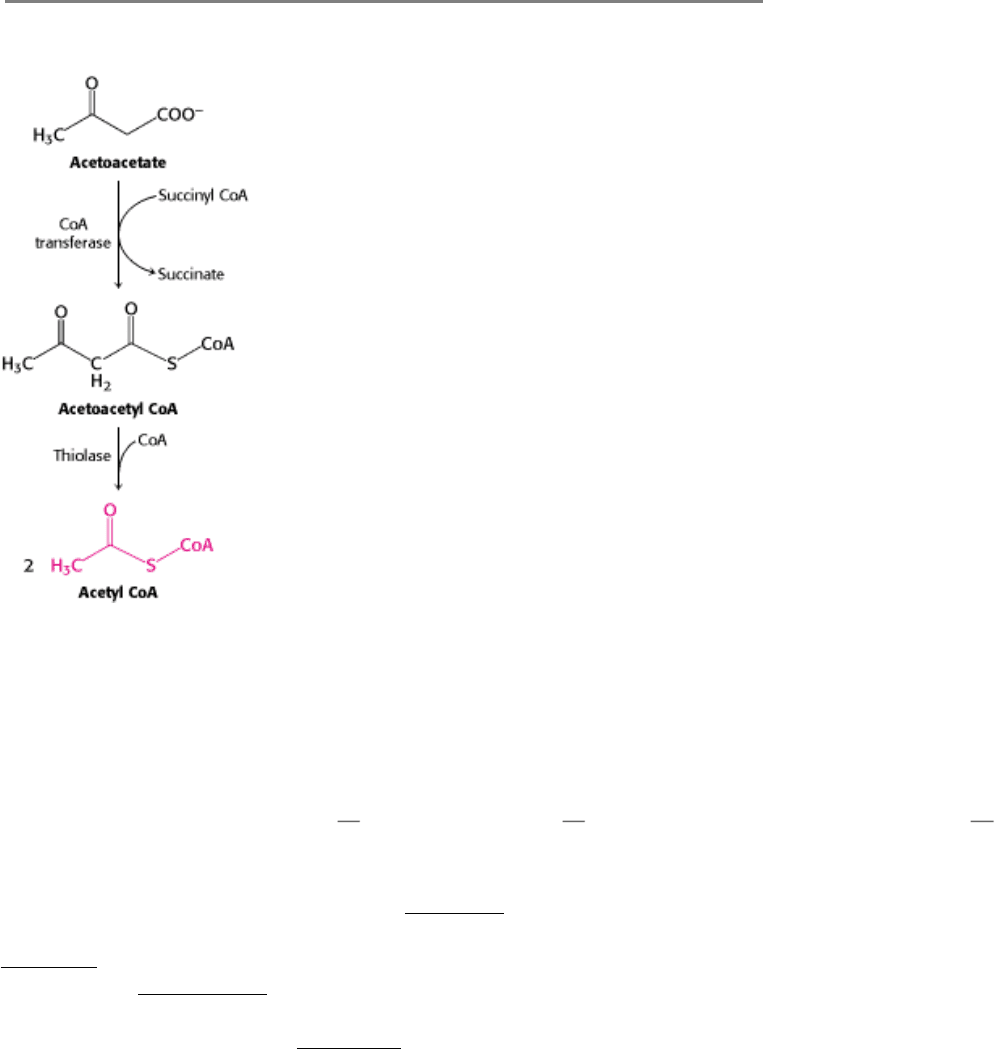
Glucose 150 80
Ketone bodies 150 150
III. Synthesizing the Molecules of Life 30. The Integration of Metabolism 30.3. Food Intake and Starvation Induce Metabolic Changes
Figure 30.18. Entry of Ketone Bodies Into the Citric Acid Cycle.
III. Synthesizing the Molecules of Life 30. The Integration of Metabolism
30.4. Fuel Choice During Exercise Is Determined by Intensity and Duration of
Activity
The fuels used in anaerobic exercises
sprinting, for example differ from those used in aerobic exercises such as
distance running. The selection of fuels during these different forms of exercise illustrates many important facets of
energy transduction and metabolic integration. ATP directly powers myosin, the protein immediately responsible for
converting chemical energy into movement (Chapter 34). However, the amount of ATP in muscle is small. Hence, the
power output and, in turn, the velocity of running depend on the rate of ATP production from other fuels. As shown in
Table 30.3, creatine phosphate (phosphocreatine) can swiftly transfer its high-potential phosphoryl group to ADP to
generate ATP (Section 14.1.5). However, the amount of creatine phosphate, like that of ATP itself, is limited. Creatine
phosphate and ATP can power intense muscle contraction for 5 to 6 s. Maximum speed in a sprint can thus be
maintained for only 5 to 6 s (see Figure 14.7). Thus, the winner in a 100-meter sprint is the runner who slows down the
least.
A 100-meter sprint is powered by stored ATP, creatine phosphate, and anaerobic glycolysis of muscle glycogen. The
conversion of muscle glycogen into lactate can generate a good deal more ATP, but the rate is slower than that of
phosphoryl-group transfer from creatine phosphate. During a ~10-second sprint, the ATP level in muscle drops from 5.2
to 3.7 mM, and that of creatine phosphate decreases from 9.1 to 2.6 mM. The essential role of anaerobic glycolysis is
manifested in the elevation of the blood-lactate level from 1.6 to 8.3 mM. The release of H
+
from the intensely active
muscle concomitantly lowers the blood pH from 7.42 to 7.24. This pace cannot be sustained in a 1000-meter run (~132
s) for two reasons. First, creatine phosphate is consumed within a few seconds. Second, the lactate produced would cause
acidosis. Thus, alternative fuel sources are needed.
